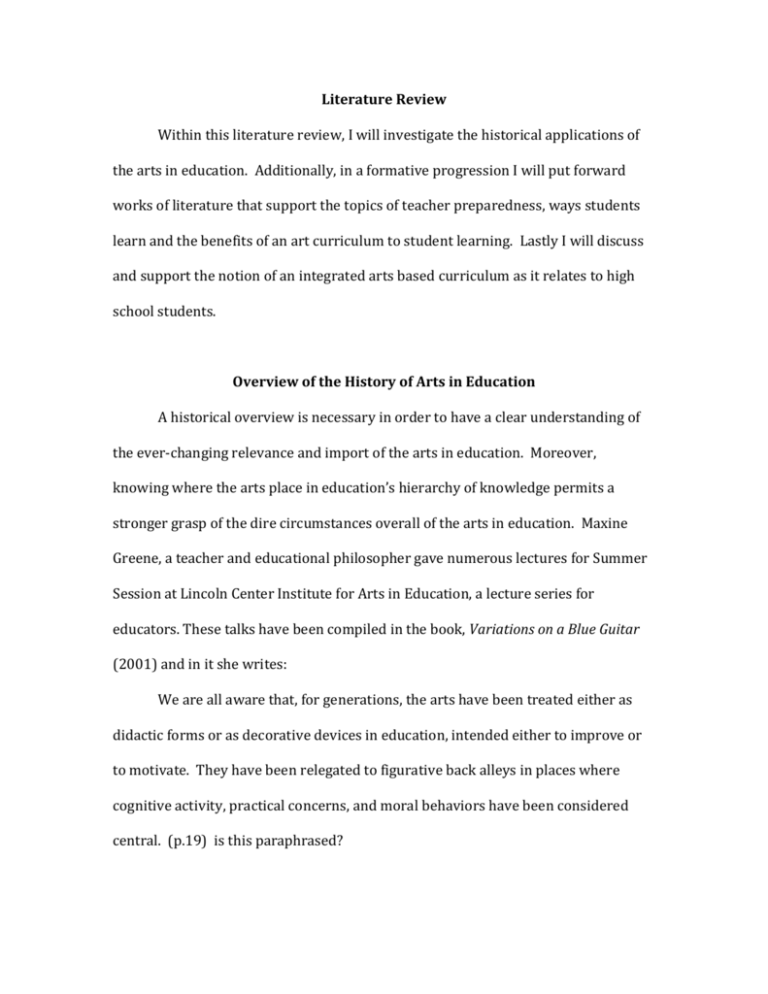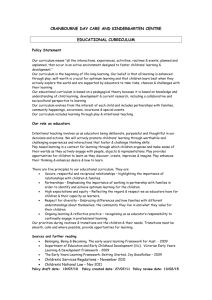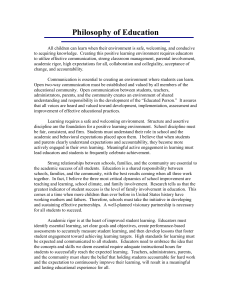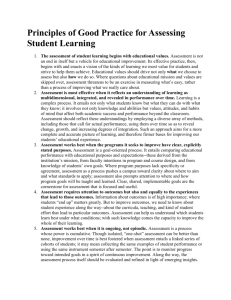Literature Review
advertisement

Literature Review Within this literature review, I will investigate the historical applications of the arts in education. Additionally, in a formative progression I will put forward works of literature that support the topics of teacher preparedness, ways students learn and the benefits of an art curriculum to student learning. Lastly I will discuss and support the notion of an integrated arts based curriculum as it relates to high school students. Overview of the History of Arts in Education A historical overview is necessary in order to have a clear understanding of the ever-changing relevance and import of the arts in education. Moreover, knowing where the arts place in education’s hierarchy of knowledge permits a stronger grasp of the dire circumstances overall of the arts in education. Maxine Greene, a teacher and educational philosopher gave numerous lectures for Summer Session at Lincoln Center Institute for Arts in Education, a lecture series for educators. These talks have been compiled in the book, Variations on a Blue Guitar (2001) and in it she writes: We are all aware that, for generations, the arts have been treated either as didactic forms or as decorative devices in education, intended either to improve or to motivate. They have been relegated to figurative back alleys in places where cognitive activity, practical concerns, and moral behaviors have been considered central. (p.19) is this paraphrased? In her writing, Greene presumes a communal knowledge of educational curriculum but this is simply due to the fact that these writings were directed towards educators, however, her ideas are shared by numerous others. In Does Art History Go to School? (1986), Lynn Galbraith and Marvin J. Spomer investigate how art teachers incorporate art history into their classrooms. The authors, in looking to the past, find that “research has shown that art history and art appreciation have not been accorded an appropriate intellectual status in schools and are at times neglected” (p. 10). In an effort to update these findings, Galbraith and Spomer sent out 148 questionnaires to art teachers in junior and senior high schools in rural, suburban and urban areas in the Midwest. What they discovered is that the majority of teachers use art history in supportive roles to art practice with no real meaningful study of the art objects themselves (p. 11). Galbraith and Spomer present three possibilities for why teachers may not teach art history more prominently in their classrooms. First, the teacher’s curriculums may limit time allowed for art history; second, they may not feel comfortable teaching the subjects; last, teachers may not have a specific interest in art history. The authors make mention of the Getty-funded Discipline-Based Art Education (DBAE) and the emphasis it places on the four disciplines of art: art production, art criticism, art history, and aesthetics, but what this article mostly provides is statistical data as to how art history is incorporated in the classroom by teachers. Their general conclusions reiterate the apparent neglect of art history teaching in the classroom and the apparent need of assistance by art teacher to incorporate it into the classroom in a more prominent way . Another article that investigates how art history is introduced in the classroom is Stuart Richmond’s article, Art, Imagination, and Teaching: Researching the High School Classroom (1993). Richmond gathered a team of researchers and gave them the task of creating individual case study reports based on classroom observations, field notes, and informal interviews. What Richmond’s research discovered was that in younger grades there is a very prescribed curriculum, and as students get higher in grade level, they are allowed more freedoms. In these higher grades, art history, art criticism and aesthetics are “integrated with practical work as needed to provide background knowledge, rather than being treated systematically as distinct areas” (p. 374). Richmond and his team argue that effective art education as administered by an imaginative teacher should find a balance between the academic elements of art and the student’s creative and interpretive freedoms that are exhibited in their studio work. Like Richmond, Tom Anderson in Attaining Critical Appreciation Through Art (1990) writes of a full art curriculum and the teachers role within that curriculum. He investigates what he deems effective teaching that fosters “critical appreciation”. In looking into Discipline Based Art Education (DBAE) and creativity-based curriculum, Anderson finds that “the pursuit of self-determined goals, the ability to integrate external criteria in the resolution of problems encountered in reaching those goals and the ability to judge… whether goals have been met and performance is appropriate and adequate” (p. 139), are skills most heavily supported by the visual arts. This in a nutshell is “critical appreciation”. Anderson’s Ideal program in art education would include art studio, art history, art criticism, and aesthetics. In building off of “critical appreciation” skills and melding them with DBAE ideas, Anderson advocates for a curriculum he terms Competency-Based Critical Appreciation, which measures competency not only in content, but also in a student’s ability to make decisions. This is a key point to keep in mind when thinking of student learning and understanding. What they learn in the classroom needs to translate and transfer to their world outside the classroom. Teacher’s Preparedness In order for all effective arts learning to occur in the classroom, there is need for a knowledgeable guiding force to lead the way. As an art teacher with an everchanging body of students, as well as constantly expanding and progressing subject matter, continued professional training is imperative. According to Maxine Greene (2001), we, as educators “are hardly…in a position to develop heightened sensitivity in others if we ourselves do not know what it is like to live inside, to move around within the range of art forms” (2001, p.8). If a teacher is to teach, then it is necessary for him or her to be familiar with the content of their field of study. Essentially they need to speak the language of their subject. Opportunities for continued teacher training and education are indispensible to the ideal of an integrated arts curriculum. Numerous organizations and institutions offer occasions for continued professional training. Art 21, presented through PBS, serves educators and their students by providing free materials and programs devoted to the exploration of contemporary art and artists. Similarly, many museums including the Museum of Modern Art, the Whitney the Guggeghnheim etc, offer professional development workshops which focus on helping teachers to learn how to integrate modern and contemporary art in their classrooms. In Contemporary Art and the Role of Interpretation (2002), Helen Charman and Michaela Ross write about another program. Offered at Tate Modern’s Summer Institute for Teachers, this experience is held for four weeks in the summer and brings together a group of educators and administrators from a varying array of institutions and experiences. Each week has a “way of looking” model established by the institution. In this sense, all participants were focused on the same task in the same way, an equalizer of sorts. The aim of the program was to instill confidence to educators in using modern and contemporary art in their classroom teaching. Using what they call “actionresearch”, each participant became a researcher, actively engaging in the process as well as the making. Ultimately what they hope to make clear is the expansive quantity of material found in contemporary art in addition to the fact that there is a definitive connection between interpreting art and making art. Although numerous benefits to teachers is exhibited through these programs and others like it, such as instilling confidence and motivating educators to include formerly unfamiliar content, teacher training should be as inclusive as the content presented to students and should provide opportunities in all areas of art. In Relationships among Art Teachers’, Art Critics’ and Historians, and Non-ArtTrained Individuals’ Statements about “Guernica” (1970), Brent Wilson seeks to determine whether teachers possess the necessary language skills to facilitate discussions as art historians or art critics. In his research, Wilson collected written responses to Guernica from thirty-one art teachers, twenty-one junior and senior education majors as well as the writings of twenty-one historians and critics. In comparing these writings systematically, Wilson discovered significant differences in three categories: inferred meaning, context, and style. In the end, Wilson discerned that, “if it is thought desirable for art teachers to function as historians and critics, then…additional training in methods of inquiry in these disciplines seems necessary” (p.39). Certainly ideas of art education and teacher training have changed since the time this article was written but the questions raised by Wilson are still relevant in today’s educational systems. The expectations placed on art educators have rightly expanded and as such educational guidelines need to follow suit. Besides the efforts of museums in addressing the need for teachers’ training and professional development, you may want to briefly mention how the DOE has also made attempts with the advent of the new curriculum for the arts in 2004 to train teachers in the use of the Blueprint integrated curriculum. How Students Learn Education consists of multiple layers of people and ideas. Within a school institution these layers may be prescribed simply as administrators, educators and students, with numerous under layers among and between. One of the under-layers imbedded amid teacher and student is student learning. There is no one definitive line that is capable of capturing the parameters by which a student does, will, or can learn. Simply put, as individuals, we learn individually. And with the history of art education, the study of student learning is very diverse and ever changing. Dennis Atkinson observes in Art in Education: Identity and Practice (2002), that “the development of children’s and student’s learning in art practice has been theorized from a range of perspectives” (p.6). He notes that current trends are concerned with contexts and experiences connected to the real world. “In education this means trying to attend to the ways in which teachers and learners experience classroom practices that are culturally derived” (p.7). These varying perspectives facilitate a broader understanding of students, educators and the classroom. In Learning Theories and Education: Toward a Decade of Synergy (2005), John Bransford investigates aspects of human learning, most importantly those aspects that are central to educators (p.2). He makes the distinction between implicit learning, that which we learn without intense study, and explicit learning, that which requires a stronger more focused examination. Bransford suggests that in recent studies it is presented that “it may not be the material per se that distinguishes implicit from explicit learning, but how the material is presented to learners” (p. 7). Similarly, A Learning Cycle Approach to Art History in the Classroom, by Joanne E. Sowell, discusses the varying ideas regarding the many disciplines of art. She writes, “it is not the discipline of art history which violates learning theory, but the methods which often have been used to teach it” (p. 19). She suggests a “learning cycle approach” to teaching that would allow children to explore concepts actively, specifically from exploration, to invention, to application. (p. 20) Another article that touches on the subject of how students learn is an article by Carole K. Henry, Retention and Recall of Images: Evaluating Museum Experiences of Schoolchildren (1992 ). In examining a specific group of students from a rural community outside of Atlanta who visited a museum on a school field trip, Henry investigates the benefits of a student’s interactions with original works of art, in doing so she is able to garner information on whether or not a student is able to retain and recall information regarding the art work they have seen. In her research, Henry looks into the psychology of learning and particular studies pertaining to an individual’s ability to retain information. Henry is focused on the benefits of museum education and the promotion of school field trips, but her main directive is highlighting whether or not a student is able to retain and recall information having been directly exposed to the object from which the information comes. Additionally, through her study of the psychology of learning, Henry finds much support for the benefits of a comprehensive art education. One in particular found that “verbalization and visual association combined was more successful than either…alone” (p. 84). Ultimately what Henry argues is that a student’s experience with a work of art needs to be supported in order for that child to carry that learning beyond the moment. For Henry it is the visit to museums that enables this extended learning, however it is compulsory that these external environments are not the sole contributor to such learning; an in-school curriculum infused with art educational experiences could certainly foster these same sorts of learning experiences. Benefits of the arts to student learning Once we become familiar with how students learn and a teacher’s preparedness, there arises the question of the benefits of the arts to student learning. How are these benefits exhibited? Champions of Change: The Impact of the Arts on Learning (1999) is one document that investigates these benefits. This document was funded and supported by numerous educational and governmental agencies. It advocates for the incorporation of an arts curriculum, as it is capable of enhancing overall learning. Numerous researchers, over a number of years, analyzed and investigated many school systems and documents in order to establish a marker for student learning as it pertains to the inclusion of arts education. The researchers feel that in the current environment, as it is necessary to have measurements and data driven analysis, there is a need to examine a way of registering the benefits of arts in education. They ascertain that an educational curriculum that perceptively includes the arts presents an increase in student achievement. “It appears that a narrowly conceived curriculum, in which the arts are either not offered or are offered in limited and sporadic amounts, exerts a negative effect on the development of critical cognitive competencies and personal dispositions” (p. 58). The researchers not only looked at traditional institutions, but also stepped outside to investigate other programs and their benefits to student learning. “Creative youth-based nonschool organizations and enterprises that have sprung up in response to this ‘institutional gap’ engage young people in productive activities during nonschool hours” (p. 35). This extensive document and its research corroborates the notion of increased learning benefits on students who have access to strong art programming. Project Zero is an educational research group at Harvard University with the mission to understand and enhance learning, thinking, and creativity in the arts, as well as humanistic and scientific disciplines, at the individual and institutional level. Their Studio Thinking Project’s research discovered eight categories of learning that they refer to as “habits of mind”. These habits of mind consist of, develop craft, engage & persist, envision, express, observe, reflect, stretch & explore, and understand art world. In each of these categories it is clear to see their link to the arts, but when looked at more closely, extensive learning can be seen. For example, Stretch and Explore is described as, “Learning to reach beyond one’s capacities, to explore playfully without a preconceived plan, and to embrace the opportunity to learn from mistakes and accidents” (Studio Thinking, 2010). This sort of learning can certainly extend beyond the art classroom into other areas of study or perhaps even further into their personal lives. A push for integrated arts curriculum The Blueprint for the Arts is a document researched and presented by a number of agencies and individuals involved in various aspects of the arts and education in New York City. It was promulgated and implemented as the official art curriculum for the arts in nyc. Envisioned as a guideline, the Blueprint establishes five standards by which an arts curriculum should be presented: Art Making, Literacy in the Visual Arts, Making Connections, Community and Cultural Resources, and Careers and Lifelong Learning. When taken as a whole, these standards provide opportunities for students to “become literate in art, make social, cultural, and historical connections, engage in learning beyond the classroom, share in the rich diversity of their communities, and become lifelong learners and advocates for art” all the while being engaged in meaningful art making (p.5). Additionally these elements bring into a single curriculum the various ways by which students see, feel and interpret both their immediate environment and the external world. Jessica Hoffman Davis in Why Our Schools Need The Arts (2008) argues for integrated arts curriculums. “Because of the tangibility of the arts, students see the impact of their thinking (process) on the art object (product), and experience as no other subject will allow the range and importance of their own inquiry and their own ability to assess and direct that process. These are invaluable skills for working in any subject or setting – the ability to ask real questions that lead to further study (inquiry) and the ability to continuously assess, revise, and advance the work (reflection). These essential skills have implications for performance in any arena, but are uniquely acquired through the arts in education. (p.74) Dorinne Dorfman in Arts Integration as a Catalyst for High School Renewal (2008) writes about Woodland High School, a small high school in rural Vermont. A small number of administrators and teachers from this school launched an arts academy that aimed to create “an experiential yet academically vigorous pathway for a small ‘community of artists’” (p. 51). As this school is in infancy, there was a severe learning curve, but ultimately a positive overview of student learning and achievement was attained. Towards the end of the initial year, the school district brought in a researcher to evaluate the program. What was discovered was that those students who had been “bored, frustrated and angry with traditional schooling had now become deeply engaged, active learners” (p. 55). What was also observed was that these students did not maintain a balance of importance across the board and began to hold the arts at a higher level than their academic courses.




